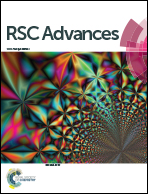High-yield and environment-minded fabrication of nanoporous anodic aluminum oxide templates†
Abstract
Nanoporous anodic aluminum oxide (AAO) templates, fabricated via anodization, have been widely studied in fundamental science and industry, for use as functional nanostructures in opto-electronics, membrane filters, energy storage devices, bio-applications, magnetic memory, etc. However, conventional AAO fabricating techniques have several disadvantages, such as the relatively long time required, inefficient usage of resources, and their toxicities, which restrict their practical application. This paper reports on a high-yield and environment-minded fabrication method for nanoporous AAO templates, accomplished through simultaneous multi-surface anodization and direct detaching of AAOs from an aluminum (Al) substrate by applying stair-like reverse biases in one electrolyte. These procedures can be repeated for mass production (i.e., high yield) using the same Al substrate. The nanoporous AAO templates fabricated here were used to synthesize gold (Au) nanowires (NW) with a diameter of ∼25 nm. This development, together with the modulation of physical properties of Au NWs, can enrich the potential of future nanotechnology based on nanoporous templates, and can also contribute to green technology owing to its minimized toxicity as well as its efficient use of resources.


 Please wait while we load your content...
Please wait while we load your content...